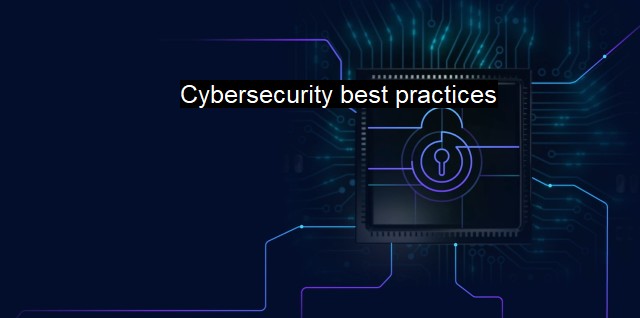What are Cybersecurity best practices?
Ensuring Online Safety: A Guide to Cybersecurity Best Practices and the Role of Antivirus Software in Protecting Networks and Data
Cybersecurity, often known as information technology security, refers to measures taken to protect computers and data from theft, damage, disruption, or misuse. Cybersecurity best practices are essential in maintaining integrity, security, and privacy of information. These practices recommend steps necessary to effectively manage security systems and protect against threats and vulnerabilities.The concept of cybersecurity revolves around the use of touchscreen technologies and connections, such as the Internet, as well as the protection of electronic systems and networks from potential risks. Businesses, government institutions, and individuals alike need to understand the importance of cybersecurity to maintain the security, integrity, and privacy of their systems and sensitive data.
The severity of cyber threats makes it necessary to actively implement cybersecurity best practices. The first step involves implementing a firewall which serves as a barrier or shield that prevents harmful forces or unauthorized users from accessing your network. To further mitigate potential harm, you should lock your network and make sure access is limited to specific persons or systems. Providing individual credentials to each user and efficient management of authorization rights will also contribute to improved cybersecurity. Regularly updating and strengthening these access controls increases the security of your digital information.
Antivirus software plays a crucial role in cybersecurity. Cybersecurity best practices demand this software be kept up-to-date to handle the latest threats effectively. Antivirus software works by scanning a computer system for known types of malware and then quarantining or deleting these threats. An up-to-date antivirus allows you not just to discover malicious software more comprehensively but also to remove these threats more effectively.
Email security is another pillar of cybersecurity. Email is an essential medium to communicate personal, business, and official information, making it a target for cybercriminals. Receiving an unfamiliar email with an infected link or attachment can infect your system with malware. To safeguard against such attacks, you need to handle emails with great care. Also, it's a good idea to use encrypted emails which encode the content ensuring only the intended recipient can read it.
Cybersecurity best practices also dictate that you should secure your hardware. It's not just online threats that jeopardize your cybersecurity; physical security also plays a influential role. Unprotected hardware can be either physically stolen or tampered with, causing immense data loss or breach. Therefore, physical devices that contain vital information should be secured properly and kept under diligent surveillance.
Another essential practice that complies with efficient cybersecurity management includes regularly backing up data. Even the best protective measures can prove ineffective against an ingenious and persistent hacker. In such instances, having data backups can ensure the loss is remediated and extensive damage averted.
Timely software updates form a vital part of cybersecurity best practices. These updates not only bring in new features and improved interface but also fix security vulnerabilities. Prompt installation of updates can nullify numerous phishing attacks and prevent the exploitation of vulnerabilities.
User training is a necessary practice in cybersecurity. Often, breaches occur due to human error, lack of awareness or negligence. Training programs raise awareness on various cyber threats and provide the tools to recogn, respond, and recover from attacks.
Lastly, monitoring and logging access to your systems not only helps identify potential attacks but also ensures that only authorised individuals or systems have network access.
Cybersecurity best practices are a set of guidelines that, when followed properly, can minimize the risk of cyber threats. These practices span across hardware and software updates, user training to raise threat awareness, regular data backup, email and physical security among others. The increasing sophistication and prevalence of cyber-attacks makes the adoption of these practices absolutely necessary for the security, integrity, and privacy of sensitive data.

Cybersecurity best practices FAQs
What are some basic cybersecurity best practices?
Some basic cybersecurity best practices include installing and regularly updating antivirus software, using strong and unique passwords, enabling two-factor authentication, being cautious of suspicious emails and links, and regularly backing up important data.Why is antivirus software important in cybersecurity?
Antivirus software is important in cybersecurity because it can detect and block or remove malicious software, such as viruses, malware, and spyware, from your devices. It helps protect your personal and sensitive information from being stolen or compromised by cybercriminals.What should I do if I suspect a cybersecurity breach?
If you suspect a cybersecurity breach, you should immediately disconnect from the internet and shut down your device. You should then contact IT support or a cybersecurity professional to assess the situation and take appropriate action, such as removing malware, identifying and repairing vulnerabilities, and changing passwords. You should also report the incident to the appropriate authorities, such as your employer or law enforcement agencies, if necessary.How can I stay updated on the latest cybersecurity threats and trends?
You can stay updated on the latest cybersecurity threats and trends by regularly reading reputable cybersecurity news sources, attending cybersecurity conferences and events, and following cybersecurity experts and organizations on social media. You should also consider joining online communities and forums where you can share knowledge and best practices with other cybersecurity professionals.| | A | | | B | | | C | | | D | | | E | | | F | | | G | | | H | | | I | | | J | | | K | | | L | | | M | |
| | N | | | O | | | P | | | Q | | | R | | | S | | | T | | | U | | | V | | | W | | | X | | | Y | | | Z | |
| | 1 | | | 2 | | | 3 | | | 4 | | | 7 | | | 8 | | |||||||